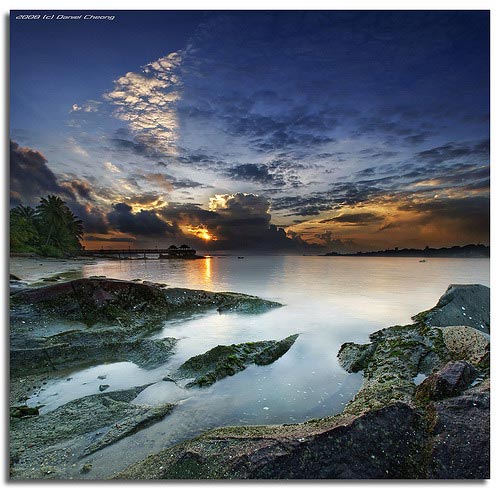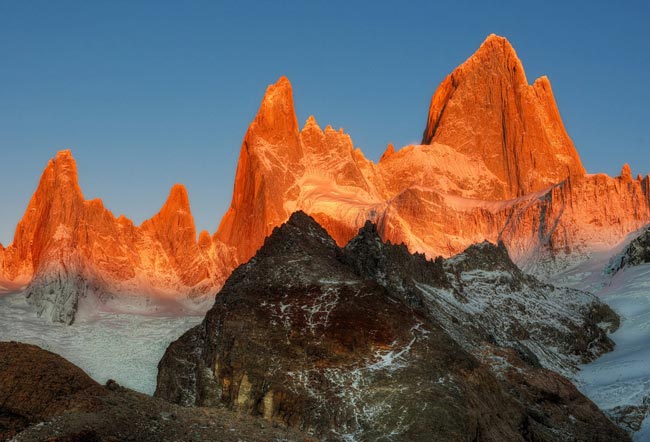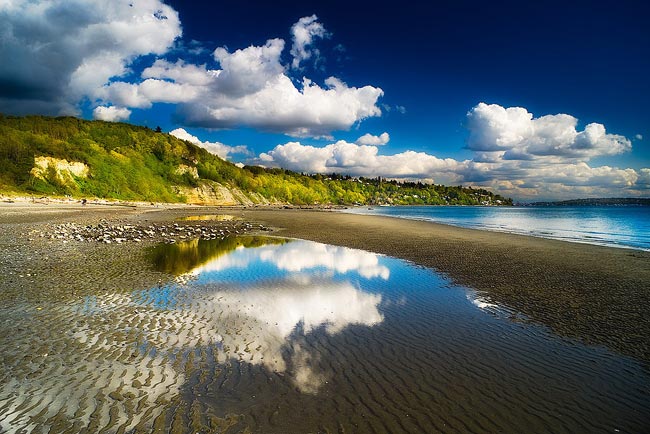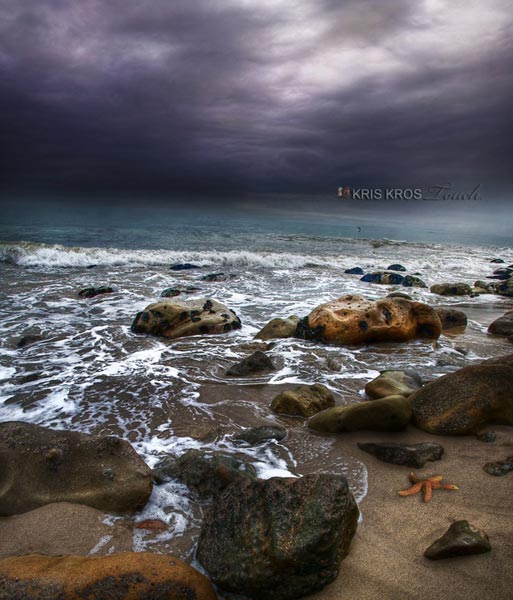SYMPHONIC MOMENTS IN HDR

Image: Pulau Ubin Sunrise. © Daniel Cheong,
used by written permission.
Learn more about this photographer on the last page of the article, along with the unique characteristics of all of these maestros, plus so much more. You won’t want to miss it.
Composing high dynamic range (HDR) photographs is like conducting an orchestra with the settings as the individual musicians. Cue the right notes, at the right time, and silence all the other players. Success lies both in the cuing and the silencing. Think of a well-composed HDR photograph as a Symphonic Moment.
HDR processing uses two main techniques, tone mapping and exposure blending. Tone mapping is a way to compress the tones, often using Photomatix®, to bring out an adequate range of tones for monitor display. Exposure blending uses layers and masks, in Photomatix and Photoshop® together, to select the best parts of many images and put them together in a more manual process.
There are many kinds of HDR nature photographers: those realists who want to accurately revive the scene before them; impressionists who want to catch the impression that a landscape leaves upon them; and others in between. In this article, the emphasis is on excellent photographers and their emotional attachment to their subject, not on their specific HDR settings.
Learning to see HDR imagery means letting go of rigid fixations on techniques at either end of this spectrum and returning to the picture itself. A creative picture is a subjective experience that involves both photographer and viewer. Photographers in this article emphasize naturalistic pictures with subtle HDR processing, yet are concerned primarily with the symbolic meaning they see in their subjects.
With the introduction of digital HDR images, viewers were shocked because biases governed how we saw them: it was common to view them relative to landscapes made from film. Some critics insisted that the HDR image should be both true to nature and a beautiful object. Over-insistence on truth, and habitual notions of beauty, echoes the mindset of mid 19th-century viewers.
Critics often misunderstand the impact of HDR work and overlook master photographers. Why? The critics attacked tone mapping, a setting in HDR software programs that tries to keep details while reducing contrast which can result in halos or a painting-like look. However, tone mapping can be subtle, or dramatic so its effects are seen. Bashing the appearance of HDR pictures, repeated in countless web discussions, is now a tired cliché. Fact check ― tone mapping is only sparingly employed by experienced HDR image makers to maximize detail without image noise. Think of non-subtle tone mapping, perhaps, as the heavy metal of the HDR music world. It has its place at one end of the spectrum of HDR techniques.
WHY THESE PHOTOGRAPHERS?
A Flickr member since 2002, I met these eight photographers through the Flickr.com website. By September 2009, a single HDR group on Flickr had 480,000 photographs, so I’m obliged to explain why I chose this small group: they were selected because they shared unique characteristics of master photographers, not because their work represents the best HDR of all time. Personally, their work illuminates these characteristics, and shows their character.
Nature can renew the spirit. This is the message behind all these photographs. With pristine wilderness remaining only a scant 5% of the American countryside, and shrinking worldwide, nature is in jeopardy. Creating their seascapes and landscapes, these maestros define where they personally fit into the natural realm. Here is their work from Patagonia, Italy, Germany, the American West and around the world.

Photographer: Trey Ratcliff. A Razor to the Sky, © Trey Ratcliff 2009, used by written permission. See more of Trey’s photos….
Mount Fitz Roy is a high peak in Patagonia between Chile and Argentina. There, Trey Ratcliff was inspired to catch the dawn light while working in freezing winds, after a sleepless night suffering from altitude sickness. Trekking in these conditions up to this granite spire shows, without doubt, an absolute fidelity to the medium of adventure photography. Like the native, first-nations name of this mountain peak, “Smoking Mountain,” Ratcliff’s career is also smoking with a hot-selling book out called A World of HDR.
In 2009, Ratcliff entered a cityscape into Smithsonian contest. After submitting his image to their ‘Altered Images’ category, he learned they disqualified the photo, saying it did not fit the category but did not explain their decision. Ratcliff’s low-key response was to write them in support of difficult choices they faced in choosing winning images from so many entries. Sharing the story on his blog, Ratcliffe’s ethical honesty showed the strength of his character. Unique characteristics of a photographer are a central part of judging their work.
Ratcliff notes that “the more you do HDR, the more you notice different light levels.” Some of his images show a rebirth of what I call “Pictorial HDR.” Like the Pictorial photography movement over 100 years ago, Pictorial HDR is emotive and atmospheric. It is influenced by the ways Impressionist painters evoked emotion through color representation. Mr Ratcliff says: “Impressionist images go deep into viewers’ brains and evoke memories of shared scenes and events. The memory is in fact an Impressionist playground of fleeting colors, shapes and edges. A face here, a blur there, a hint of something almost there, but not quite. Look at Monet’s work. Think about how the yellows of a sun in the distance is the same yellow as an up-close flower. But something about the colors makes the sun feel brighter than the flower.”
It is helpful to think about the history of photography, and how painting and photography have influenced each other, when seeing HDR images. Modern HDR themes revive those of the Pictorial photography movement. That movement believed photography should emulate painting and etching to become art, so that pictures with emotion and atmosphere would depict personal artistic expression. Pictorialists thought images with emotion were more interesting than photographs concerned only with realism. Today with HDR software we are re-working past themes from the painters art.
The 1880’s were years that reached a crescendo of the Realists vs. Impressionists in photography. The English photographer Dr. Peter Henry Emerson proposed a theory of vision. Arguing that photography should imitate the eye, he knew the eye saw sharpness only at the center of what was viewed, while the periphery of vision appeared blurred. As a result he made his platinum prints sharp only in the center and slightly out of focus towards the edges, seeking a naturalistic photograph. Prior to Emerson, edge-to-edge sharpness was a photographer’s main concern. Although criticized for being in a “fuzzy school,” the work of Emerson and his promotion of photography as an independent Pictorial art became the foundation for the Photo-Secessionist school. This controversy seems to be repeated in our current HDR debates about how HDR images should appear.
While I agree with Ratcliff that at times memory seems like a playground of colors and shapes, I believe that our memory, like our visual scanning, works in a much more active and dynamic way with complex links to our attentional process. Our image making, like any behavior, is complex. We actively search for scenes to photograph. Some of these scenes are evocative, and are reminiscent of our past experience. At times photography is created from seeking out novel images that echo our past experiences. Memorable HDR images are, like symphonic melodies, complex creations with interesting ideas at their center.

Photographer: Chris Tarnawski. Image Above: Transcendence © Chris Tarnawski 2009, used by written permission. View more photos…
From Seattle, Mr. Tarnawski provided background on this photograph: “Discovery Park is the place where I transcended seeing the world as objects and started seeing it as shapes. I clearly recall the very moment it started happening and I’ve been using this ability in my photography ever since. Hence the title of this shot. HDR has expanded my palette, (it) gave me a lot more depth to work with.” He adds “Nature photography is where I let go and fly with whatever moves me, no time limits, no set boundaries, just me and the feeling inside.”
The experience of a timeless, boundless flow is a delight of doing nature photography. Tarnawski’s photograph shows the Discovery Park beach near the Magnolia neighborhood of Seattle, Washington, in the northwestern United States.
Until recently, Discovery Park was the U.S. Army’s Fort Lawton. History was not what brought Tarnawski back to photograph there, however. It was a timelessness and a sense of wildness that drew his interest. His image deftly weaves reflection, a wide angle, and humans for scale. Making “Transcendence,” Tarnawski changed his artistic vision as he actively saw shapes in place of objects in his landscapes.

Photographer: Joe Dejesus. Image Above: A Star in the Storm © Joe Dejesus 2009 and used by written permission. Joe has more photos to see…
Mr. Dejesus has been working with HDR since its inception. His photographs were shown in a New York Times piece by Ian Austen in 2006. Dejesus’s work above shows powerful time contrasts. The details of the starfish, clouds and a bird bind us to a single tempo in time that overlies the ocean’s infinite rhythm of timelessness.
The color saturation does not shout that this is an HDR scene, yet the increasing dynamic range keeps detail in low light areas. “A Star in the Storm” is an intimate primal seascape along the Pacific coast, and the title points loosely to the idea that humans, perhaps, are hitch hiking around a small star at the edge of an immense galaxy.
The photographic symphony continues…
by Jim Austin, M.A., A.C.E.

Leave a Reply